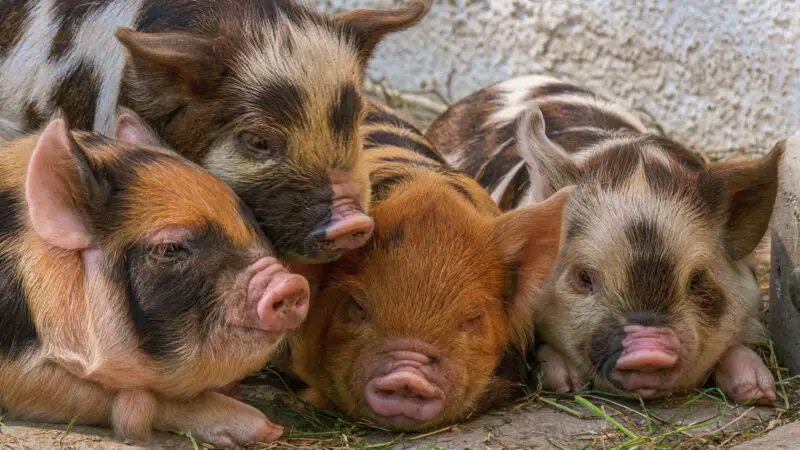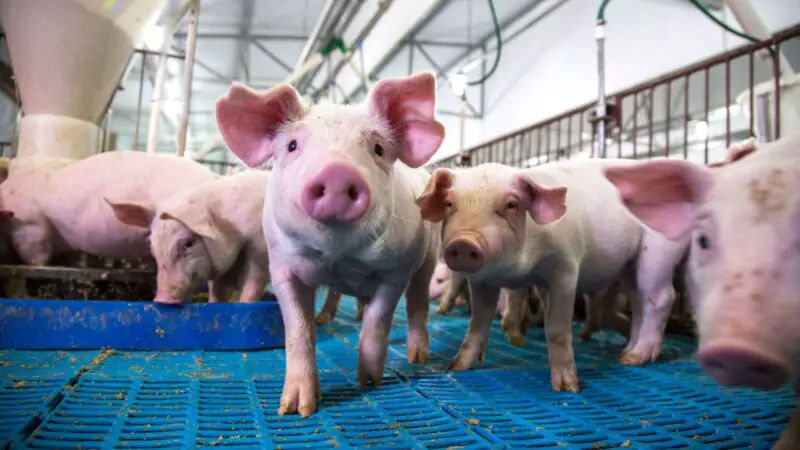Pigs are intelligent, social animals with fascinating behaviors and characteristics. In this article, we’ll explore 14 adorable facts about pigs, ranging from their exceptional sense of direction to their unique communication abilities.
If you’re curious about pigs and want to learn more about these lovable creatures, this article is for you. Keep reading to discover interesting tidbits about pigs that might just surprise and delight you.

Pigs have an excellent sense of direction
Did you know that pigs have an incredible sense of direction? They can find their way home from great distances and remember locations with remarkable accuracy. This navigational prowess is particularly useful when pigs forage for food or explore new territories.
Pigs suffer immensely on factory farms
Unfortunately, many pigs endure terrible conditions on factory farms. These intelligent animals are often confined to cramped, unsanitary spaces, which can lead to stress, illness, and injury. It’s essential to support humane farming practices and promote better treatment for pigs.
By 2 weeks old, newborn piglets can recognize their own names and run to their mothers’ voices

Piglets develop strong bonds with their mothers early in life. By the time they’re just two weeks old, these little ones can recognize their own names and respond to their mothers’ voices. This early bonding helps to ensure a strong family unit and social structure within the group.
Adult pigs can sprint up to 11mph, or a seven-minute mile
Despite their size and somewhat cumbersome appearance, adult pigs are surprisingly agile. They can sprint at speeds of up to 11 miles per hour, which is roughly equivalent to a seven-minute mile. Their athleticism allows them to evade predators and traverse various terrains with ease.
Pork is connected with fertility and virility in China, in addition to saving lives
In Chinese culture, pork is often associated with fertility and virility. Additionally, pig organs have been used in life-saving medical procedures, such as heart valve replacements. This highlights the diverse ways in which pigs have played a role in human lives throughout history.
Pigs can swim in a clean sea as well as wallow in dirt
While pigs are often associated with wallowing in mud, they’re also proficient swimmers. They can navigate through water with ease and enjoy taking a dip in the ocean or a clean pond. This swimming ability helps them to escape predators and keep cool during hot weather.
Pigs are very clean animals
Contrary to popular belief, pigs are quite clean animals. They prefer to keep their living spaces tidy and will designate specific areas for sleeping, eating, and elimination. Pigs wallow in mud primarily to cool off, not because they enjoy being dirty.
Mother pigs sing to their babies

One of the most endearing aspects of pig behavior is the way mother pigs, or sows, sing to their piglets. This gentle vocalization helps to soothe and comfort the babies, strengthening the bond between mother and offspring.
Pigs talk incessantly, and over 20 distinct vocalizations have been found
Pigs are quite chatty animals, with over 20 different vocalizations identified by researchers. These sounds serve various purposes, such as communication among group members, expressing emotions, or signaling the presence of food.
Pigs will devour everything, including human bones
Pigs are omnivorous creatures with voracious appetites. They will eat almost anything, including human bones. This fact has led to some macabre stories and urban legends about pigs being used to dispose of human remains.
Related: Do Pigs Eat Meat? | All You Need to Know!
Pigs don’t sweat, so wallowing in the mud is a great way to cool off
Since pigs lack functional sweat glands, they can’t cool off by sweating like humans do. Instead, they rely on wallowing in mud or water to lower their body temperature. This behavior also serves as a natural sunscreen and helps protect their skin from parasites and insects.
Pig squeals can reach 115 decibels

When pigs communicate, they can produce some impressively loud sounds. A pig’s squeal can reach up to 115 decibels, which is comparable to the noise level of a rock concert or a jet engine. While these sounds can be startling, they play a crucial role in pig communication and socialization.
Pigs are also very bright and sociable
Pigs rank among the smartest animals on the planet, displaying advanced problem-solving skills and social intelligence. They can learn tricks, recognize themselves in mirrors, and even play video games. Their strong social bonds and complex group dynamics further illustrate their remarkable cognitive abilities.
Not only can pigs dream like humans, but their genetic composition is quite similar
Another fascinating fact about pigs is their similarity to humans in terms of genetics and physiology. Pigs share many genetic traits with humans, and they even have the ability to dream like us. These similarities have made pigs valuable models for medical research, helping scientists better understand human biology and develop new treatments.
Final Thoughts
Pigs are truly remarkable animals with a wealth of interesting and endearing qualities. From their exceptional intelligence to their strong social bonds, these lovable creatures have much to teach us about the natural world. By learning more about pigs and celebrating their unique characteristics, we can foster a greater appreciation for these amazing animals and advocate for their welfare.
